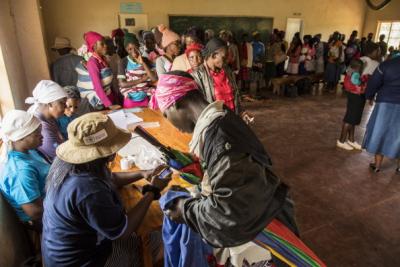World must act to help southern Africa, WFP

JOHANNESBURG AND LONDON – A record 45 million people in the 16-nation Southern African Development Community are gravely food insecure following repeated droughts, widespread flooding and economic problems, the United Nations’ World Food Programme announced Thursday.
The WFP warned that the world must act immediately to save lives and allow communities to adapt to climate change.
“This hunger crisis is on a scale we’ve not seen before and the evidence shows it’s going to get worse,” said WFP’s regional director for Southern Africa, Lola Castro.
“The annual cyclone season has begun, and we simply cannot afford a repeat of the devastation caused by last year’s unprecedented storms.
“While our most pressing priority are the millions in need of immediate support, building the resilience of the many more threatened by increasingly frequent and destructive droughts and storms is absolutely essential,” Castro added.
As the “lean” season deepens before the annual cereal harvest in April and May, the international community must accelerate both emergency assistance to millions of desperately hungry people in southern Africa, and long-term investments to enable the region’s vulnerable to withstand the worsening impacts of climate change, WFP said.
According to WFP, temperatures in southern Africa are rising at twice the global average, most of the food produced by subsistence farmers is entirely dependent on increasingly unreliable rains – which arrived late again this year in many areas – and southern Africa has had just one normal growing season in the last five years. Experts predict the hot and dry weather will continue in the coming months, presaging another poor harvest.
WFP plans to provide lean season assistance to 8.3 million people grappling with “crisis” or “emergency” levels of hunger in eight of the hardest-hit countries: Zimbabwe, Zambia, Mozambique, Madagascar, Namibia, Lesotho, Eswatini and Malawi.
WFP reports it has secured just 205 million US dollars of the 489 million required for these operations, and has been forced to resort heavily to internal borrowing to ensure food reaches those in need.
Zimbabwe is suffering its worst hunger emergency in a decade, with 7.7 million people – half the population – seriously food insecure, WFP said. 20 per cent of people in Zambia are also seriously food insecure, despite the country being a longtime regional breadbasket – it is now having to restrict cereal exports and accept outside assistance. 20 per cent of the population of drought-stricken Lesotho are also now severely hungry, as are ten percent of Namibians.
In a context of already high rates of malnutrition, population growth, inequality, and HIV/AIDS, the hunger crisis is being aggravated by surging food prices, large-scale livestock losses and mounting joblessness, WFP said. Families across the region are eating less, skipping meals, taking children out of school, selling off precious assets and falling into debt.
“If we don’t receive the necessary funding, we’ll have no choice but to assist fewer of those most in need, and with less”, said Castro. “Nor will we be able to adequately expand longer-term activities vital to meaningfully combatting the existential emergency that is climate change.”
im


